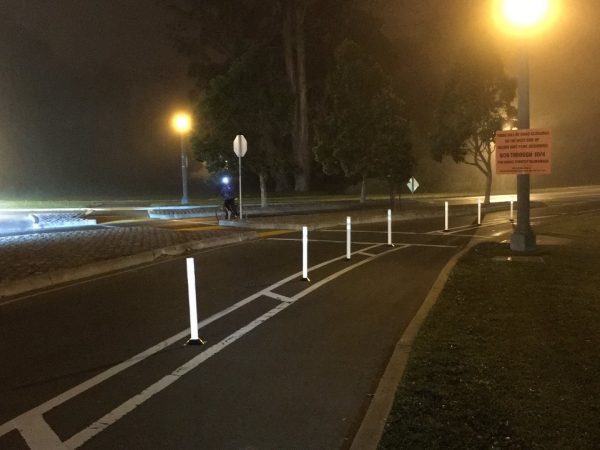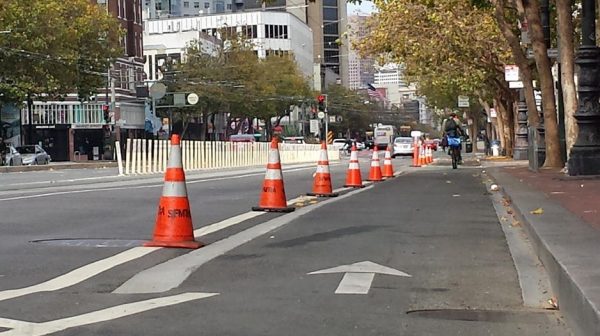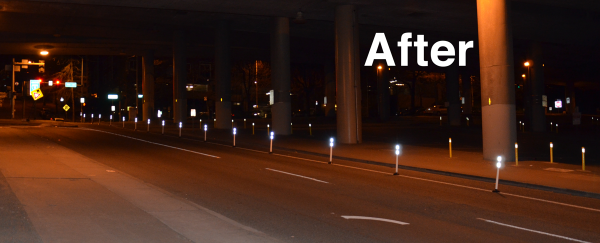When two cyclists were tragically killed in hit-and-run collisions this past summer, a group of anonymous urban activists known as the San Francisco Transformation Agency erected a set of protected bike lanes using traffic cones. Usually such guerrilla interventions are temporary. They raise awareness but ultimately get taken down by municipal authorities. But when the same group recently (and illegally) installed a set of soft-hit posts alongside Golden Gate Park, the city reacted by making the change official.

The SFMTrA, a play on the city’s Municipal Transportation Agency (SFMTA), “is a collective organization of men and women committed to making streets safer for cyclists and pedestrians, and doing it quickly.” According to the organization, their members use tactical urbanism to accomplish a range of objectives, including:
- Provide a real safety increase for cyclists and pedestrians.
- Draw attention to areas of the city that are unsafe for vulnerable pedestrians and cyclists.
- Put pressure on the SFMTA and public officials to make proactive, rapid and substantive improvements in street safety.
Many of their interventions involve orange traffic cones, which do grab visual attention but are also impermanent and easily damaged. Adding more robust traffic delineators (also known as soft or safe hit posts) may have helped persuade the city to retain this particular recent installation along John F. Kennedy Drive.

“Generally, we have no choice but to remove cones and posts that do not go through an official process,” wrote the city agency in a statement, “because it’s a code violation to place objects in the roadway, and they could create conflicts for various types of traffic.” But in this case, they plan to install official safe hit posts and leave the temporary ones in place until their review process is complete.

Guerrilla activists in other cities have tried similar things with mixed results. When the group Reasonably Polite Seattleites installed a similar set of delineators along a stretch of road in Seattle, the city initially took them down. Subsequently, though, officials wrote the activists an exceedingly nice response and eventually agreed to reinstall the posts.

City traffic engineer Dongho Chang of the Seattle Department of Transportation explained that a combination of issues (including the height of the posts and state control of the street) forced the removal at first. At the same time, he acknowledged the “time, money and risk” invested by the group and even offered to give the posts back. He later followed up with a letter indicating the city and Washington State Department of Transportation would put the delineators back in place.
In New York City, a perhaps less-polite group has been known to take things even further by building out entire bike lanes from scratch. After a local community board rejected plans to extend an extant lane, Right of Way took to the streets at night to paint their own. As a catalyst, the group cited an accident that took place after a taxi driver struck a pedestrian (after reportedly arguing with a cyclist sharing the lane).
Guerrilla interventions like these can provoke a variety of responses from critics and cities alike. In some cases, tactical urbanists are celebrated by communities but also jailed or fined by officials for their actions. In other instances, though, such installations can give a city an opportunity to publicly support a direction of change. In San Francisco, which has already built out 27 miles of protected bike lanes over recent years, the city seems to be signalling it is open to progress.



Comments (13)
Share
The phrase “hit-and-run accident” is an oxymoron. If you don’t know who the perpetrator was, you certainly can’t determine their motivation.
Well, if the perpetrator just left the scene, I think that says a lot about thst person. Not providing help at an accident scene is illegal, not to mention highly immoral (especially if you caused the accident)
I think that’s Eric’s point. It’s a collision, not an accident. When a pedestrian or cyclist is wounded or killed by a driver, it’s a collision. Occasionally it’s an accident too, but it’s usually preventable, a senseless result of our problematic car culture.
Sounds like a great initiative.
I hate bicyclists.
……because? How can you just make a statement like that and not say at least why? There is no room on 99percentinvisible.org for the word “hate”….perhaps, “I am annoyed at bicyclists because…..”
Wow, thats harsh. You hate bicyclists? I hate cars, but I don’t have anything against the drivers. Why should a motorist have any more rights to use the road than a bicyclist that also pay taxes for the roads to be built? Just because they payed more for their vehicle?
That’s an unfortunate comment. We should all get along together and share the road as it was intended.
We’ve got a lot of this sentiment this week here in the UK as changes are being made to the guidance given to road users, as it pertains to cycling safety.
It’s unnerving to think that there are people who think like this who are in charge of 2 tonne metal boxes on wheels sharing road space with vulnerable people on two wheels.
All power to the groups who are putting in segregated cycle infrastructure to keep people safe. Thank you
Thank you for this excellent article on the crucially important work these activists are doing! One minor quibble though is with the word ‘accident,’ which can be construed as absolving the person, and moreover the system, responsible for these casualties. The AP Stylebook now recommends: “When negligence is claimed or proven, avoid accident, which can be read as exonerating the person responsible.” There is now an effort among activists who have lost friends and family members to traffic violence, as well as those who themselves have suffered grave injuries from such, to advocate for the use of more descriptive words such as ‘crash’ or ‘collision’ in describing these events (see: crashnotaccident.com).
As long as the bicyclists stay within the barriers that’s fine.
If people cycling (and let’s not leave out people on tricycles to carry children, improve stability, carry cargo etc, eh?) aren’t using the lanes, there is something wrong with the lanes. Maybe they’re full of potholes, never swept, give way at driveways and side-roads, too narrow, in the car-door zone, full of pedestrians, have poor visibility, provides no method to turn across traffic lanes, will shortly run out at a dangerous junction or pinch point etc. The vast majority of people are not going to preferentially put themselves in front on one and a half tonnes of metal unless the other option is bad. This is a design site, after all: if people aren’t acting in the way you designed for, the design is wrong.
If people cycling (and let’s not leave out people on tricycles to carry children, improve stability, carry cargo etc, eh?) aren’t using the lanes, there is something wrong with the lanes. Maybe they’re full of potholes, never swept, give way at driveways and side-roads, too narrow, in the car-door zone, full of pedestrians, have poor visibility, provides no method to turn across traffic lanes, will shortly run out at a dangerous junction or pinch point etc. The vast majority of people are not going to preferentially put themselves in front on one and a half tonnes of metal unless the other option is bad. This is a design site, after all: if people aren’t acting in the way you designed for, the design is wrong.